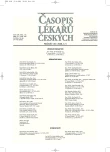-
Medical journals
- Career
Cefepime as an Empiric Treatment of Febrile Neutropenia in Patients after High Dose Therapy and Autologous Stem Cell Transplantation
Authors: E. Žikešová; M. Hnátková; B. Vacková; A. Jedličková 1; P. Klener; M. Trněný
Authors‘ workplace: I. interní klinika 1. LF UK a VFN, Praha ; ÚKDBL Klinická mikrobiologie a ATB centrum VFN, Praha 1
Published in: Čas. Lék. čes. 2006; 145: 383-389
Category: Original Article
Overview
Background.
Febrile neutropenia is one of the most frequent complications in intensively treated hematooncological patients and almost inevitably occurs after high dose therapy and autologous stem cell transplantation. Empiric broad-spectrum antibiotic treatment is indicated in the initial management. Fourth-generation cephalosporins are the option. This retrospective study was initiated to assess efficacy and safety of cefepime as an empiric therapy of febrile neutropenia following high dose therapy and autologous stem cell transplantation.Methods and Results.
319 high dose therapy procedures with autologous stem cell transplantation in 287 patients mostly with hematological malignancies were performed at our department between January 2002 and December 2005. We present analysis of 169 out of 229 febrile episodes in 163 patients (median age 53) being treated with cefepime in the initial empiric treatment of febrile neutropenia. 12 episodes (7.1 %) were clinically documented (pneumonia 9, sinusitis 2, acute cholecystitis 1), 60 (35.5 %) were confirmed microbiologically (presented as bacteremia) and 97 (57.4 %) were fever of unknown origin. 50 isolates (83.4 %) out of 60 microbiologically documented infections were G-positive bacteria, 8 isolates (13.3 %) were G-negative bacteria and 2 (3.3 %) were mixed G-positive and G-negative cultures. According to the MASCC score 14 episodes were assessed as high risk. Effect of cefepime as a single agent was observed in 85 episodes (50.3 %) and in 22 (13.0 %) episodes treated with combination therapy due to susceptibility of isolated pathogen in blood culture. Combination therapy of two antibiotics (cefepime + aminoglycoside or glycopeptide) given for persistent fever was effective in 13 patients (7.7 %). Treatment failure was observed in 48 (28.4 %) episodes, we registered 10 death.Conclusions.
Therapy with cefepime represents an appropriate choice for empiric antibiotic treatment of febrile neutropenia in hematooncological patients. Cefepime demonstrates clinical safety and efficacy and can be used in monotherapy or in combination with other drugs (overall response 72.2 %, as a single agent 50.3 %).Key words:
febrile neutropenia, high-dose therapy, transplantation, cefepime.
Labels
Addictology Allergology and clinical immunology Angiology Audiology Clinical biochemistry Dermatology & STDs Paediatric gastroenterology Paediatric surgery Paediatric cardiology Paediatric neurology Paediatric ENT Paediatric psychiatry Paediatric rheumatology Diabetology Pharmacy Vascular surgery Pain management Dental Hygienist
Article was published inJournal of Czech Physicians

-
All articles in this issue
- Chronic Visceral Ischemia – Diagnostic and Therapeutic Problem
- NGAL-Neutrophil Gelatinase Associated Lipocalin in Biochemistry, Physiology and Clinical Praxis
- Chronic Myeloid Leukemia – Resistance to Imatinib Mesylate (Glivec®)
- Cefepime as an Empiric Treatment of Febrile Neutropenia in Patients after High Dose Therapy and Autologous Stem Cell Transplantation
- Hereditary Form of Thrombotic Thrombocytopenic Purpura
- Sentinel Lymph Node Biopsy in Oral and Oropharyngeal Carcinomas
- Mammotome, New Technique not Only for Breast Cancer
- Penetrating Aortic Ulcers – Casuistry of Endovascular Therapy
- Informed Consent in the View of Sociology
- Vascular Involvement in Thoracic Outlet Syndrome
- Superior Vena Cava Syndrome – Potential of the Intervention Therapy
- Prevention of Thrombembolic Disease in Internal Medicine
- Buerger’s Disease
- Endovascular Treatment of Acute Vascular Occlusions
- Epidemiology of Peripheral Arterial Occlusive Disease
- Journal of Czech Physicians
- Journal archive
- Current issue
- Online only
- About the journal
Most read in this issue- Buerger’s Disease
- Vascular Involvement in Thoracic Outlet Syndrome
- Superior Vena Cava Syndrome – Potential of the Intervention Therapy
- NGAL-Neutrophil Gelatinase Associated Lipocalin in Biochemistry, Physiology and Clinical Praxis
Login#ADS_BOTTOM_SCRIPTS#Forgotten passwordEnter the email address that you registered with. We will send you instructions on how to set a new password.
- Career

